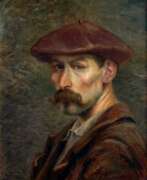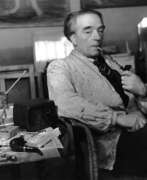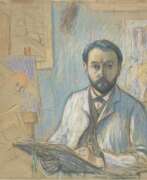Portrait Synthetism
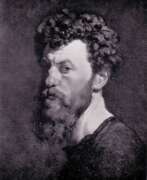

Louis Anquetin, a French painter, was a distinctive figure in the Post-Impressionist movement, known for his development of the Cloisonnism style alongside Émile Bernard. This style is characterized by bold outlines and flat areas of color, significantly influencing the aesthetic directions of their contemporaries. Anquetin’s career began in Paris, where he immersed himself in the avant-garde art scene, mingling with notable artists like Henri de Toulouse-Lautrec and Vincent van Gogh.
Louis Anquetin's works, such as "The Avenue de Clichy at Five o'clock" and "Woman at the Champs-Élysées by Night," reflect his fascination with Parisian street scenes and the vibrant nightlife of the city. These works are celebrated for their dynamic use of color and form, capturing the essence of urban life with a dramatic flair.
In the later part of his career, Anquetin shifted his focus towards studying the techniques of the Old Masters, particularly Pieter Paul Rubens, and even authored a book on Rubens in 1924. This marked a significant transition from his earlier avant-garde styles to a more traditional approach in his later works.
Louis Anquetin’s contributions to both the Post-Impressionist movement and his later academic studies remain influential. His works can be found in various prestigious collections, including the Musée d'Orsay and the Tate, highlighting his lasting impact on the art world.
For those interested in exploring more about Louis Anquetin's works or collecting his art, staying informed about exhibitions and sales is crucial. You can sign up for updates related to Anquetin's artwork and auction events, ensuring you never miss an opportunity to view or acquire his influential pieces.


József Boksay (Russian: Иосиф Иосифович Бокшай) was a prominent Hungarian landscape painter and graphic artist, born on October 2, 1891, in Gyertyánliget and passing away on October 19, 1975, in Ungvár. His work significantly contributed to the artistic life of Carpathian Ruthenia, making him a notable figure in the Carpathian school of painting. Graduating from the Hungarian Academy of Fine Arts in 1914, where Imre Révész was his master, Boksay embarked on a journey of teaching and creating. His post-graduation life saw him taking study trips across European cities such as Vienna, Paris, and Budapest, further enriching his artistic vision.
Boksay's dedication to the arts led him to co-found a free school with Béla Erdélyi in 1927, aiming to nurture the region's artistic talent. His academic contributions continued post-World War II, teaching at the Fine Arts College in Ungvár and the Industrial Art School in Lemberg (now Lviv). A significant portion of his works delves into religious themes, a testament to his deep engagement with ecclesiastical art. This involvement is vividly illustrated by his transformative work on the ceiling frescoes of the Máriapócs church, where he meticulously integrated baroque elements with his distinctive style.
His legacy is preserved not only in his contributions to Carpathian Ruthenia's art scene but also in the numerous awards he received for his work. Today, his creations can be found in the museums of Carpathian Ruthenia and the Tretyakov Gallery, showcasing his lasting influence on the region's cultural heritage.
For collectors and art enthusiasts interested in the unique blend of cultural and artistic expressions that define Carpathian Ruthenia, Boksay's work offers a captivating exploration. His contributions to ecclesiastical and landscape painting underscore the rich tapestry of this region's art history. Sign up for updates to stay informed about new product sales and auction events related to József Boksay, ensuring you never miss an opportunity to engage with the legacy of this distinguished artist.
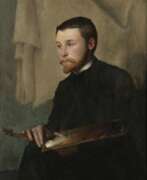

Paul Sérusier was a French Post-Impressionist painter and theorist, notable for his significant contributions to the art movement known as the Nabis. Born in Paris on November 9, 1864, Sérusier's work is characterized by its expressive use of color and pattern, inspired by the techniques of Paul Gauguin. He is best known for his exploration of color, sensation, and abstraction, particularly evident in works like "Le Talisman, the Aven River at the Bois d'Amour" (1888). This painting marks a departure from the Impressionists' more faithful representation of observed reality, focusing instead on translating sensations onto the canvas with vibrant brushstrokes and an emphasis on emotional expression over visual accuracy.
Sérusier's paintings often feature the landscapes and people of Brittany, notable for their contemplative mood achieved through firm contours and blocks of unmodulated color. His style evolved under the influence of Synthetism and Cloisonnism, favoring flattened forms and large swathes of color, as seen in "Farmhouse at le Pouldu" (1890). This approach reflects a decorative organization of objects, emphasizing the craft and execution of the scene.
Some of Sérusier's notable works are housed in prestigious museums such as the Musée d'Orsay in Paris, including "Portrait of Paul Ranson in Nabi Costume" (1890) and "Landscape" (1912). His legacy extends beyond his own artworks; he was a key figure in the formation of the Nabis movement, and his theoretical contributions have had a lasting impact on the art world.
For collectors and experts in art and antiques, Sérusier's work represents a unique blend of post-impressionist and symbolist styles, making his pieces highly valued both for their historical significance and their aesthetic appeal. To stay updated on new product sales and auction events related to Paul Sérusier, sign up for our updates. This subscription service is exclusively focused on providing information related to Sérusier's work, ensuring you remain informed about opportunities to acquire pieces by this influential artist.
